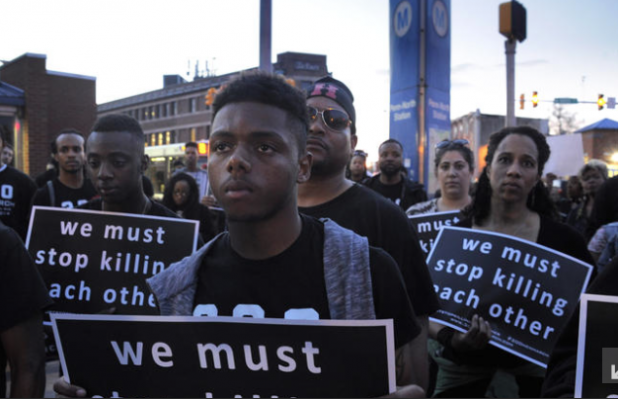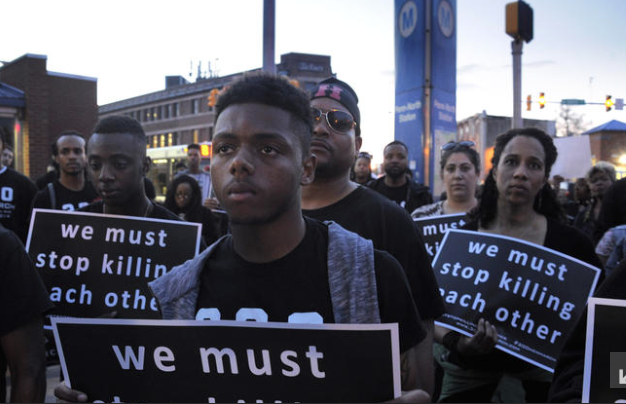Stuff Black People Don’t Like
June 16, 2015
PK Note: It’s out for Kindle. Bell Curve City is finally available. Get it here. The paperback will be out Wednesday.
Recall the black insurrection in 65% black Baltimore began on April 28.
Recall the black elected leaders of 65% black Baltimore held a symposium to highlight the scourge of black on black violence in March of 2015.

As city leaders in Baltimore debate whether or not they should pay black people not to kill one another (yes, that’s actually a consideration to stop the violence: pay people not to kill), it’s important to recall a rally that took place in mid-April 2015… before the black insurrection in the name of the heroin dealer Freddie Gray ever happened. [Street-corner rally appeals for residents to ‘stop killing each other’, Baltimore Sun, April 17, 2015]:
As drums beat and horns honked, dozens of men — and some women — stood quietly on a busy Northwest Baltimore street corner Friday night. Each held aloft a black-and-white sign with a stark message to passing motorists and pedestrians: “We must stop killing each other.”
It wasn’t a protest, but an appeal for residents to take the corner of Pennsylvania and North avenues — and the rest of the city — back from the violence that has cost so many lives and disrupted so many neighborhoods.
“Occupy the Corner,” as it was called, was the opening salvo in another year of community outreach arranged by the anti-violence group known as 300 Men March. As they have for the past two years, members plan to gather every Friday evening into the fall to walk the streets as a group and engage residents young and old in an effort to make neighborhoods safer.
“It’s great to have conferences and things like that at hotels and rec centers, but we want to take the energy right to the corners, to send a message that people do care about their communities, are frustrated by the high level of violence,” said Munir Bahar, the group’s organizer.
But Bahar, 33, a tax accountant who also runs a health and fitness business, said the 300 Men March was focused on people taking personal responsibility for what happens in their community, not looking to blame or rely on anyone else. “There are a lot of people who want to do something about the violence but don’t necessarily have the outlet,” Bahar said before Friday’s event.
“That’s why we created ‘Occupy the Corner’ — to give people an outlet, not against police violence but more specifically the day-to-day violence happening in the communities, of young folks gunning other folks down.” City Councilman Brandon Scott joined the sign-wavers, saying he hopes it will help reclaim the Penn North neighborhood from drug dealing.
“When we are engaged in our communities, we have less violence,” Scott said. Last year, the group focused its efforts in the Belair-Edison community in Northeast Baltimore, Scott said, because there had been a spate of homicides there.
During the months of activity there, he added, the number of killings dropped. Scott also drew a distinction between the anti-violence efforts of 300 Men March and the protests against police violence.
“Both issues are valid,” he said, adding that he may very well join the rally Saturday, too. But complaints about police misconduct are no excuse, he added, for failing to take personal responsibility for what goes on in the community. But Janet Carter, 50, said she thought violence in the community may be worse as a result of police abuse.
Still, she said, she was drawn by the losses she’s seen among families at the school where she works to join the 300 Men March event for the first time. “It’s very important for us to get together as a community, a people, a city — black, white, all lives matter,” she said.
On one corner stood a clutch of older, red-jacketed sign-wavers, members of the Arch Social Club. The club, founded more than a century ago, has embraced the 300 Men March, and club members join in the neighborhood walks. “In the old days, when we were out there, we would have a fistfight,” said Van Anderson, 61, the club’s president.
“But things have escalated.” Wanda Smith, 54, happened upon the sign-wavers, most clad in black T-shirts, as she was coming to pick up something to eat on the corner. “I love it,” she said. “It looks so much better.”
Lou Fields welcomed the rally, too, but suggested it wouldn’t be enough by itself to lead to permanent improvement. What’s really needed, he said, is concentrated investment in the community, job training and political leadership.
“This is very good, but it’s only symbolic,” said Field, 63, who leads African-American heritage tours. “As soon as the 300 crowd came, the evil folk left,” he said. But he added that “five minutes after they leave, it’s going to be a drug corner.”
After five minutes it might have been a drug corner, but State’s Attorney Marilyn Mosby sure was determined to make sure they weren’t going to be corners where death was peddled with the ease of a Coca Cola. [Baltimore prosecutor asked police to target area where Freddie Gray was arrested, Baltimore Sun, 6-9-15]
